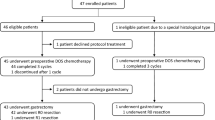Abstract
Background
A suitable treatment strategy for esophageal cancer after definitive chemoradiotherapy for T4 cases has not been established and remains unclear. This study aimed to clarify the independent prognostic factors, surgical indications, and optimal extent of lymphadenectomy for T4 esophageal cancer.
Methods
Of 803 patients who underwent esophagectomy for esophageal cancer at the authors’ institution from 2006 to March 2018, the study included 33 patients who underwent salvage esophagectomy with locally advanced T4 cancer. The study examined the baseline attributes and treatment results of these cases and evaluated the prognostic factors and treatment strategies.
Results
The independent favorable prognostic factors in T4 cancer (T4a/T4b = 11/22) included non-T4b status [hazard ratio (HR), 15.311; 95% confidence-interval (CI), 1.277–183.5] and R0 resection (HR, 14.706; 95% CI, 1.193–166.67). For the cases in which R0 resection was possible (n = 14), both the 1- and 5-year survival rates were 90.9%, whereas for the cases without R0 dissection (n = 19), the 1- and 5-year survival rates were respectively 44.9% and 0%. In the univariate analysis, the patients who underwent two- or three-field lymph node dissection tended to have a better prognosis (p = 0.062), and those with 60 or more lymph nodes dissected had a significantly better prognosis (p = 0.038). For the patients who underwent salvage esophagectomy with typical lymph node dissection, the rate of complications classified as Clavien–Dindo grade 3 or higher (33.3%) was not increased, indicating that the procedure was relatively safe.
Conclusions
The results showed that in salvage esophagectomy for T4 esophageal cancer, R0 resection led to improved prognosis. Because typical two- or three-field lymph node dissection including prophylactic dissection could be performed safely and led to a better prognosis in salvage esophagectomy, typical esophagectomy including prophylactic lymph node dissection should be performed if possible.


Similar content being viewed by others
References
Kato K, Muro K, Minashi K, et al. Phase II study of chemoradiotherapy with 5-fluorouracil and cisplatin for stage II–III esophageal squamous cell carcinoma: JCOG trial (JCOG 9906). Int J Radiat Oncol Biol Phys. 2011;81:684–90.
Makino T, Doki Y. Treatment of T4 esophageal cancer: definitive chemoradiotherapy vs chemo-radiotherapy followed by surgery. Ann Thorac Cardiovasc Surg. 2011;17:221–8.
Kaneko K, Ito H, Konishi K, et al. Definitive chemoradiotherapy for patients with malignant stricture due to T3 or T4 squamous cell carcinoma of the oesophagus. Br J Cancer. 2003;88:18–24.
Sobin LH, Gospodarowicz MK, Wittekind C. International Union Against Cancer. Oesophagus including oesophagogastric junction. In: Sobin LH, Gospodarowicz MK, Wittekind C, editors. TNM classification of malignant tumours. West Sussex: Wiley-Blackwell; 2009, p. 66–72.
Dindo D, Demartines N, Clavien PA. Classification of surgical complications: a new proposal with evaluation in a cohort of 6336 patients and results of a survey. Ann Surg. 2004;240:205–13.
Ajani JA, Winter K, Komaki R, et al. Phase II randomized trial of two nonoperative regimens of induction chemotherapy followed by chemoradiation in patients with localized carcinoma of the esophagus: RTOG 0113. J Clin Oncol. 2008;26:4551–6.
Kiyozumi Y, Yoshida N, Ishimoto T, et al. Prognostic factors of salvage esophagectomy for residual or recurrent esophageal squamous cell carcinoma after definitive chemoradiotherapy. World J Surg. 2018 (Epub ahead of print).
Kuwano H, Nishimura Y, Oyama T, et al. Guidelines for diagnosis and treatment of carcinoma of the esophagus, April 2012 edited by the Japan Esophageal Society. Esophagus. 2015;12:1–30.
Therasse P, Arbuck S, Eisenhauer E, et al. New guidelines to evaluate the response to treatment in solid tumors. J Natl Cancer Inst. 2000;92:205–16.
Eisenhauer E, Therasse P, Bogaerts J, et al. New response evaluation criteria in solid tumours: revised RECIST guideline (version 1.1). Eur J Cancer. 2009;45:228–47.
Japanese Esophageal Society. Japanese classification of esophageal cancer, 11th ed. Parts II and III. Esophagus. 2017;14:37–65.
Japanese Esophageal Society. Japanese classification of esophageal cancer, 11th ed. Part I. Esophagus. 2017;14:1–36.
Nakamura T, Hayashi K, Ota M, et al. Salvage esophagectomy after definitive chemotherapy and radiotherapy for advanced esophageal cancer. Am J Surg. 2004;188:261–6.
Tomimaru Y, Yano M, Takachi K, et al. Factors affecting the prognosis of patients with esophageal cancer undergoing salvage surgery after definitive chemoradiotherapy. J Surg Oncol. 2006;93:422–8.
de Manzoni G, Pedrazzani C, Pasini F, et al. Chemoradiotherapy followed by surgery for squamous cell carcinoma of the thoracic esophagus with clinical evidence of adjacent organ invasion. J Surg Oncol. 2007;95:261–6.
Kawasaki S, Sato H, Tsubosa Y, et al. A case of recurrence of cervical esophageal cancer after definitive chemoradiotherapy underwent photodynamic therapy and cervical lymph node dissection. Jpn J Gastroenterol Surg. 2010;43:27–32.
Udagawa H, Ueno M, Shinohara H, et al. The importance of grouping of lymph node stations and rationale of three-field lymphoadenectomy for thoracic esophageal cancer. J Surg Oncol. 2012;106:742–7.
Ohkura Y, Shindoh J, Ueno M, et al. Comparison of outcome of esophagectomy versus nonsurgical treatment for resectable esophageal cancer with clinical complete response to neoadjuvant therapy. Ann Surg Oncol. 2018 (Epub ahead of print).
Ted CL, Jerry MS, Prashanth N, et al. Analysis of intensity-modulated radiation therapy (IMRT), proton and 3D conformal radiotherapy (3D-CRT) for reducing perioperative cardiopulmonary complications in esophageal cancer patients. Cancers. 2014;6:2356–68.
Author information
Authors and Affiliations
Corresponding author
Ethics declarations
Disclosure
The authors declare that they have no conflict of interest.
Rights and permissions
About this article
Cite this article
Ohkura, Y., Ueno, M., Iizuka, T. et al. Prognostic Factors and Appropriate Lymph Node Dissection in Salvage Esophagectomy for Locally Advanced T4 Esophageal Cancer. Ann Surg Oncol 26, 209–216 (2019). https://doi.org/10.1245/s10434-018-7074-5
Received:
Published:
Issue Date:
DOI: https://doi.org/10.1245/s10434-018-7074-5




